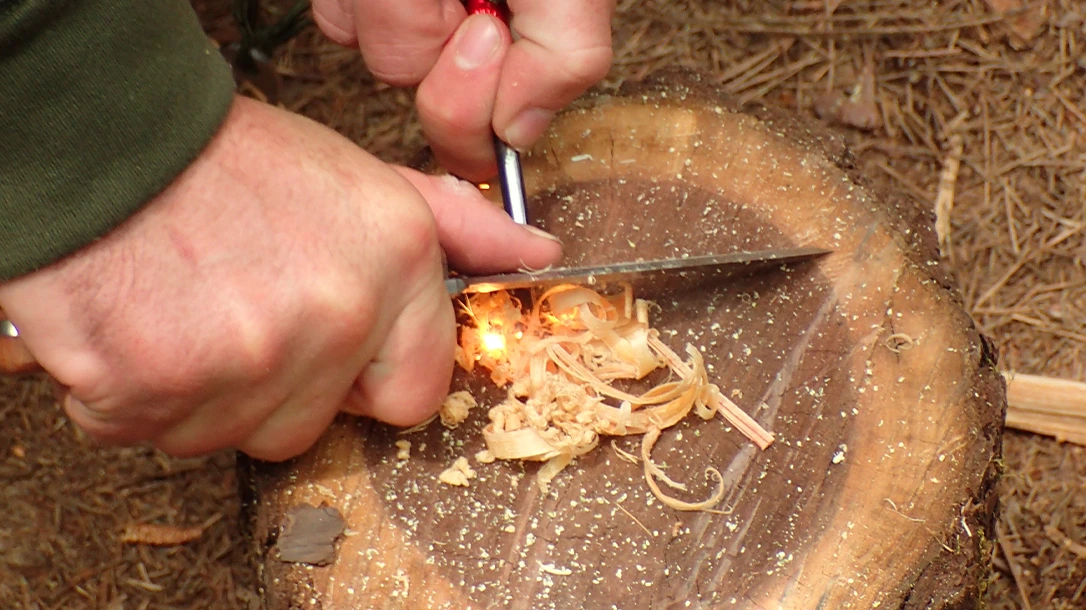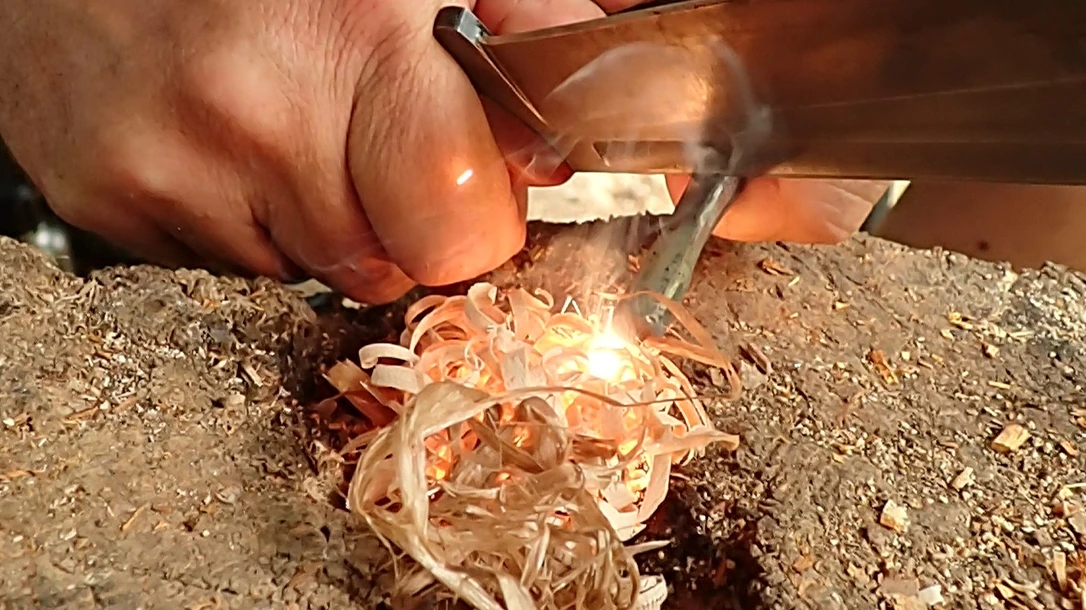For seasoned outdoor enthusiasts and enthusiastic novices alike, the Ferrocerium rod, often affectionately referred to as the Ferro rod, is a staple tool. Mastering just a handful of fundamental techniques with this tool can transform your camping experience from a frustrating struggle to ignite a warm, crackling campfire into a cozy gathering place filled with laughter and stories.
Conversely, failing to harness these skills could lead to an unsettling evening spent in quiet darkness, devoid of the camaraderie that fire brings. In more dire situations, your ability to create a fire could even mean the difference between safety and survival.

A Ferro What?
A Ferro rod is a popular tool for starting fires. It’s composed of a blend of rare earth metals, primarily cerium. This unique composition allows the rod to produce a shower of hot sparks when scraped or struck against a more rigid surface, such as steel.
The process works by removing small bits of material at high speed, which ignites due to the intense heat generated during the friction. When utilizing a Ferro rod, they can create sparks that exceed temperatures of 3,000 degrees Fahrenheit (1,650 degrees Celsius), making them sufficient to ignite dry materials like grass, bark, or specialized tinder.
To effectively use the rod, flammable material must be positioned close to where the sparks land, ensuring that they catch fire quickly. By mastering the Ferro rod technique, outdoors enthusiasts can successfully create fires in various conditions, proving its value for camping, hiking, and survival situations.
Ferro vs Matches and Lighter
When starting a fire in the great outdoors, the Ferro rod puts up some serious competition against matches and lighters. Let’s break down the benefits, shall we?
First up, let’s talk durability. Matches can disintegrate in damp conditions, and a lighter can just up and quit when you need it most, leaving you in a bind. But a Ferro rod? It’s like the cockroach of fire-starting tools—nearly indestructible. Drop it, soak it, toss it in your backpack like you don’t care; this little beauty will keep producing sparks like it’s getting paid for it.
Then there’s the versatility factor. A Ferro rod can spark a fire in pretty much any weather—from the heart of a rainstorm to the windy plains of a desert. Matches and lighters might fizzle out when the humidity hits. Well, those can struggle, too. But with a Ferro rod, you’re practically giving the weather the middle finger and still getting that fire going.
Let’s not forget about sustainability. With a lighter, once it’s out of fuel, it’s just a fancy paperweight. Matches? Once they’re burnt, it’s game over. A Ferro rod, however, can ignite hundreds of fires before you even think about replacing it. So, you’re not just lighting a campfire but investing in your outdoor adventures.
Using a Ferro rod is like wielding a magic wand of flames. There’s something satisfying about creating sparks with just a few swipes, adding ruggedness to your camping experience. You’ll feel like an adventure hero, even if you’ve spent half the day watching squirrels.
So, skip the lighter or matches next time you camp. Grab a Ferro rod and enjoy the sparks! The right natural or synthetic tinder is key to effective fire-starting.

Know Your Tinder
Both natural and synthetic options have their advantages. Natural tinder is easily sourced in the wild, while synthetic tinder is often more reliable in harsh conditions. A mix of both in your kit ensures you’re prepared for various scenarios. Which of these do you think you’ll try first?
Natural Tinder:
1. Dry Grass: These lightweight materials catch sparks easily and burn quickly.
2. Birch Bark: Contains natural oils that make it highly flammable, even when slightly damp.
3. Wood Shavings: Thinly shaved dry wood, often from softwoods like cedar, ignites readily.
4. Coconut Fiber: The fibrous husk of coconuts works well when shredded.
Synthetic Tinder
1. Cotton Balls (with Petroleum Jelly): Lightweight, easy to carry, and ignites with minimal sparks. The petroleum jelly extends the burn time.
2. Commercial Fire Starters: Pre-made cubes or sticks for reliable fire-starting.
3. Steel Wool: Super fine-grade steel wool can catch sparks easily and burn intensely.
5. Wax-Dipped Materials: Cotton pads or sawdust coated with wax provide a waterproof, slow-burning option.
Spray and Pray
Here’s a term that applies to how a video gamer would use submachine guns in any Halo game (throwback). Unfortunately, it also applies to Ferro rod techniques for many. I’ve seen this in almost every survival class I’ve taught. It seems to be the most intuitive way to use this tool. Heck, I did this for a long time before I got smart. Usually, a beginner will hold the Ferro rod over the tinder and scrape towards the tinder pile with the striker. It seems logical—the sparks must get into that pile to ignite, right? Two major flaws in this action are that the sparks are usually too far away from or knock over or crush your tinder. So, when does this technique work? Luck and using very light, fluffy tinder like a cotton ball or dryer lint. With every unsuccessful strike, you are wasting your valuable resources.
The remedy? Plant the tip of your Ferro rod directly in front of your tinder. You can plant the tip onto the tinder using fibrous tinder like poplar, birch, cedar bark, or a cotton ball. This ensures the striker won’t fling away your tinder. Place your striker as far up the rod as you can. Using friction, scrape down the rod, stopping before the end of your rod to throw sparks onto your tinder. This method takes control, but there’s still the risk of displacing your tinder.
Pull-Back
Pulling the Ferro rod back against the striker eliminates the chances of displacing your tinder, unlike with the spray and pray method. There are two main ways to pull off this technique. Keep the striker (or the back of your knife if it has a sharp 90-degree) stationary above the tinder and pull the Ferro rod backward against it. This technique gives you better control, ensuring you don’t accidentally scatter your tinder while striking. It’s essential to get as close as possible to the tinder to direct the shower of sparks accordingly. This method works exceptionally well on fluffy and loose tinder but not great on wood shavings from a feather stick.
Another way to use the Pull-back technique is to use a knife with a sharpened spine (90-degree) or a Swiss Army Knife saw. Place the knife on a solid surface, like a piece of wood that won’t roll. You can even baton the blade into the wood for maximum stability. Place the tinder next to the knife blade (away from you) and place the Ferro rod directly over the tinder and against the knife’s spine. Holding the knife with your non-dominant hand, use your strong hand to draw the Ferro rod back with maximum pressure to create an intense shower of sparks.
This method won’t scatter your tinder and effectively directs the sparks onto it. However, it requires a solid surface to plant the knife or saw. It won’t work on a top-down fire where the tinder is on top.
Thumb on Thumb
This is the most advanced Ferro rod technique of the three, which takes a lot of practice. At first, you may sacrifice a little skin, similar to a Nintendo thumb. A harder composite Ferro rod and a sharp striker or knife spine are better for this method. Where the previous techniques produce a shower of sparks, think of this way as using your rod like a sniper rifle. The sparks are more pinpointed and intentionally concentrated.
To use the thumb-on-thumb or thumb-assisted method with a Ferro rod, start by gripping the rod firmly in one hand, keeping your thumb positioned securely on top for stability and towards the rod’s tip. Hold the striker or the back of a knife blade in your other hand, placing it against the rod. Then, press the thumb of your striker’s hand against the thumb holding the ferro rod, stacking them to provide additional leverage. With both thumbs steady, push the striker firmly and smoothly down the rod, shaving off material to create a concentrated spray of sparks. It’s essential to use a lot of pressure for maximum friction as if you’re digging into the rod to create an intense spark!
This method enhances control, ensures precision, and makes directing sparks into your tinder easier, especially in challenging conditions. This method is my go-to for fluffy, loose, or stubborn tinders like wood shavings!

Quick Tips
For maximum leverage, use a knife with a sharpened 90-degree spine. It’s better than some of the smaller, harder-to-grip strikers included with most Ferro rods.
Get a good striker. I don’t care for a lot of the included strikers. In survival classes, it’s often a matter of changing out the striker for some students to achieve success.
Maintain a working posture when practicing firecraft. Sitting or lying down and sitting Indian-style won’t cut it. Squat, take a knee, and hover over your work, ready for action.
Friction is your friend when using a Ferro rod. Find the best part of your Ferro rod and striker and start from there.
Work with several tinders and strive for fewer strikes.






















